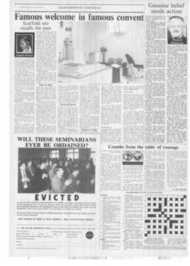Page 7, 12th July 1991
Page 7

Report an error
Noticed an error on this page?If you've noticed an error in this article please click here to report it.
Tags
Share
Related articles
Egyptians Welcomed The • Pilgrim Lady Of Fatima
Counter Reformation Launched By Moslems
Following St. Patrick Back To The Simple Faith
Journey To The Hidden Holy Land
Wheeler-dealing With Human Life, The Pawn
Ireland's ancient legacy from Egypt
Valerie Cuthbert looks at the long forgotten ties between the early churches of Alexandria and St Patrick
EGYPT, one of the most fervent Moslem countries in the Middle East, was once famous as one of the corner-stones of
early Christianity. Even today, large numbers of Egyptians, who
regard themselves as the true descendants of the Ancients, are still practising Christians.
St Mark the Evangelist, who was martyred and buried in Alexandria, where his body remained until it was taken by stealth to Venice centuries after the Arabs had conquered Egypt, is generally believed to have founded the Egyptian — known as the Coptic — Church and its Patriarch is regarded as the successor of St Mark in the same way that the Pope is the successor of St Peter in the western church.
In the early days of Christianity, the patriarch of the Egyptian church was second only in authority to Rome. It was ruled from Constantinople until the fifth century when it separated itself from the western church because of a theological disagreement with the Byzantine emperor. This rift caused nearly two centuries of bloodshed as patriarchs representing either the Greek or Egyptian creeds succeeded one another on the throne.
In the end the Egyptian church split completely from the Greek church and each went its own way.
The Egyptian National Monophysite Church emerged and, because of the way they felt towards the Byzantine church, the Egyptians no longer wished to use Greek in their churches and the liturgy and the gospels were translated into Egyptian.
The Egyptian church still celebrates the Korbin or mass in the language of the Pharaohs or, rather, the debased form of it which was spoken in the fifth century.
When the Arabs occupied Egypt in the seventh century, they tolerated their Christian subjects at first and called them Copts — a word which simply means Egyptians — and the label has stuck.
In the heart of Old Cairo, there is a Coptic museum where the most interesting and varied collection of early Christian relics have been carefully preserved. When these are examined, there is an amazing resemblance between many of the Coptic antiquities and those of the early Celtic church in Ireland.
There then emerged the probability that, although so far apart, the two Christian communities must have been in close touch with one another on religious matters during the first six centuries of the Christian era. Visits perhaps were exchanged during this period between the Irish and Coptic monks, and indeed seven Coptic monks are said to be buried at Disert Ulidh in Ireland.
Ireland was renowned for her intellectual brilliance and classical pre-eminence at a time when the rest of the world had fallen into intellectual darkness with the collapse of the Roman Empire, and during the. dark ages from the time of Charlemagne, Ireland's monks were sending Greek and Latin scholars overseas to educate and convert the rest of Europe. it is probable that the Irish monks had originally acquired their knowledge and learning in the theological schools of Alexandria in Egypt.
It has been suggested that the close association between the two countries was based on more than the occasional visits of travellers or the interchange of scholars, for the Irish continued to observe the Egyptian monastic rule after the rest of Europe had adopted that of St Benedict.
The Egyptian monastic rule, which first came to Europe in 340 AD when St Athanasius visited Rome from Alexandria, was a system of individualistic asceticism; whereas the later western development was asceticism in community. In the Egyptian system, hermits lived alone in caves and rocks and would build a number of tiny churches scattered over a wide area rather than a community centred around one large church. Anyone who has visited "The Seven Churches" of Glendalough in Co Wicklow can see a perfect example of a primitive Egyptian monastery as they existed in the desert in the early days of Christianity.
The wagon-vaulted roof as seen in Glendalough, is characteristic of the Coptic church and was in use in Egypt from the very earliest times. This type of roof is unknown in the west except in the Celtic churches in Ireland and the fact that this type of roof originated in Egypt seems to indicate yet another link between the Celtic and early Christian churches in Egypt. Built in the centre of every Egyptian monastery is a tower called a "Karr'" where the monks would flee for safety when raided by the desert tribes. The mysterious round towers of Ireland, one of which is at Glendalough, could probably have come from Egypt at the same time as the wagon-vaulted churches.
There is also a strong similarity between St Anthony, the founder of Egyptian monasticism who lived in a cave high upon a steep mountain in the desert and was tempted by beautiful women sent by the devil, and St Kevin, who founded the settlement at Glendalough — who also I: red in a remote cave and was tempted by a beautiful woman in the same way.
There is a story that once, when St Patrick entered a cave in a remote place, he saw an altar on which four glass chalices were standing. These chalices had belonged to Christians who had worshipped in Ireland long before the time of St Patrick. He was amazed, because St Urban had prescribed the use of metal instead of glass for chalices in 226 AD, over 200 years before St Patrick found the cave.
The Egyptian church, however, used glass chalices in the first century and continues to use them today. It is quite possible that St Patrick stumbled upon the Oratory of some ancient Irish hermits who had learned their Christianity in Egypt.
There are other possible links between the two countries such as the beautifully illustrated gospels in the Coptic museum which closely resemble the famous Book of Kells which is kept in Trinity College in Dublin, and the beautiful gospel-cases in the Coptic churches which resemble the Cumhdachs of Ireland.
There are bells and richly decorated and bejewelled bellshrines which are like St Patrick's hells and the famous bell-shrine of St Patrick. Another link is the carvings of wood and stone in the Coptic museum which show men and beasts within circles, which resemble the Celtic sculptumed stone crosses in Ireland.
All the circumstantial evidence points strongly to the fact that in the third and fourth centuries, Irish monks studied in the religious school of Alexandria and then returned to their own country with the knowledge and intellectual riches which they had learned from the early Egyptian church — knowledge which was to shine a light into the dark ages.
blog comments powered by Disqus











